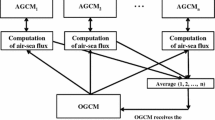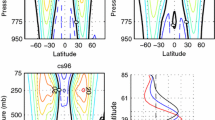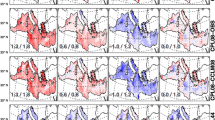Abstract
Mechanisms of the internally generated decadal-to-multidecadal variability of SST in the Atlantic Ocean are investigated in a long control simulation of the Community Climate System Model version 3 with constant external forcing. The interactive ensemble (IE) coupling strategy, with an ensemble of atmospheric GCMs (AGCM) coupled to an ocean model, a sea-ice model and a land model, is used to diagnose the roles of various processes in the coupled GCM (CGCM). The noise components of heat flux, wind stress and fresh water flux of the control simulation, determined from the CGCM surface fluxes by subtracting the SST-forced surface fluxes, estimated as the ensemble mean of AGCM simulations, are applied at the ocean surface of the IE in different regions and in different combinations. The IE simulations demonstrate that the climate variability in the control simulation is predominantly forced by noise. The local noise forcing is found to be responsible for the SST variability in the Atlantic Ocean, with noise heat flux and noise wind stress playing a critical role. The control run Atlantic multidecadal variability (AMV) index is decomposed into interannual, decadal and multidecadal modes based on the ensemble empirical mode decomposition. The AMV multidecadal mode, a combination of 50- and 100-year modes, is examined in detail. The North Atlantic Oscillation (NAO) pattern in the atmosphere, dominated by the noise component, forces the multidecadal mode through noise heat flux and noise wind stress. The noise wind stress forcing on the multidecadal mode is associated with ocean dynamics, including gyre adjustment and the Atlantic Meridional Overturning Circulation (AMOC). The AMV decadal mode is also found to be related to noise NAO forcing. The associated ocean dynamics are connected with both noise heat flux and noise wind stress, but the AMOC related to the decadal mode is more likely to be forced by noise heat flux. For both multidecadal and decadal modes, the atmospheric response to SST, including the SST-forced heat flux and SST-forced wind stress, acts as a damping.





















Similar content being viewed by others
References
Barsugli JJ, Battisti DS (1998) The basic effects of atmosphere–ocean thermal coupling on midlatitude variability. J Atmos Sci 55:477–493
Blanke B, Neelin JD, Gutzler D (1997) Estimating the effect of stochastic wind stress forcing on ENSO irregularity. J Clim 10:1473–1486
Chen H, Schneider EK (2014) Comparison of the SST-forced responses between coupled and uncoupled climate simulations. J Clim 27:740–756
Chen H, Schneider EK, Kirtman BP, Ioana I (2013) Evaluation of weather noise and its role in climate model simulations. J Clim 26:3766–3784
Collins WD, Bitz CM, Blackmon ML, Bonan GB, Bretherton CS, Carton JA, Chang P, Doney SC, Hack JJ, Henderson TB, Kiehl JT, Large WG, McKenna DS, Santer BD, Smith RD (2006a) The community climate system model version 3 (CCSM3). J Clim 19:2122–2143
Collins WD, Rasch PJ, Boville BA, Hack JJ, McCaa JR, Williamson DL, Briegleb BP (2006b) The formulation and atmospheric simulation of the Community Atmosphere Model version 3 (CAM3). J Clim 19:2144–2161
Cunningham SA, Kanzow T, Rayner D, Baringer MO, Johns WE, Marotzke J, Longworth HR, Grant EM, Hirschi JJ-M, Beal LM, Meinen CS, Bryden HL (2007) Temporal variability of the Atlantic meridional overturning circulation at 26.5°N. Science 317:935–938
Czaja A, Marshall J (2001) Observations of atmosphere–ocean coupling in the North Atlantic. Q J R Meteorol Soc 127:1893–1916
d’Oregeville M, Peltier WR (2007) On the Pacific decadal oscillation and the Atlantic multidecadal oscillation: might they be related? Geophys Res Lett 34:L23705. doi:10.1029/2007GL031584
Dai A, Hu A, Meehl GA, Washington WM, Strand WG (2005) Atlantic thermohaline circulation in a coupled general circulation model: unforced variations versus forced changes. J Clim 18:3270–3293
Danabasoglu G (2008) On multidecadal variability of the atlantic meridional overturning circulation in the community climate system model version 3. J Clim 21:5524–5544
Danabasoglu G, Yeager SG, Kwon Y-O, Tribbia JJ, Phillips AS, Hurrell JW (2012) Variability of the Atlantic meridional overturning circulation in CCSM4. J Clim 25:5153–5172
Delworth TL, Greatbatch R (2000) Multidecadal thermohaline circulation variability driven by atmospheric surface flux forcing. J Clim 13:1481–1495
Delworth TL, Mann ME (2000) Observed and simulated multidecadal variability in the Northern Hemisphere. Clim Dyn 16:661–676
Delworth TL, Manabe S, Stouffer RJ (1993) Interdecadal variations of the thermohaline circulation in a coupled ocean–atmosphere model. J Clim 6:1993–2011
Delworth TL, Zhang R, Mann ME (2007) Decadal to centennial variation of the Atlantic from observations and models. Ocean circulation: mechanisms and impacts. Geophys Monogr 173:131–148
Deser C, Blackmon ML (1993) Surface climate variations over the North Atlantic Ocean during winter: 1900–1989. J Clim 6:1743–1753
Deser C, Alexander MA, Timlin MS (1999) Evidence for a wind-driven intensification of the Kuroshio Current Extension from the 1970s to the 1980s. J Clim 12:1697–1706
Dima M, Lohmann G (2007) A hemispheric mechanism for the Atlantic Multidecadal Oscillation. J Clim 20:2706–2719
Dong B, Sutton RT (2005) Mechanism of interdecadal thermohaline circulation variability in a coupled ocean–atmosphere GCM. J Clim 18:1117–1135
Fan M, Schneider EK (2012) Observed decadal North Atlantic tripole SST variability. Part I: weather noise forcing and coupled response. J Atmos Sci 69:35–50
Frankcombe LM, Heydt AVD, Dijkstra HA (2010) North Atlantic multidecadal climate variability: an investigation of dominant time scales and processes. J Clim 23:3626–3638
Frankignoul C, Müller P, Zorita E (1997) A simple model of the decadal response of the ocean to stochastic wind forcing. J Phys Oceanogr 31:3516–3529
Hasselmann K (1976) Stochastic climate models, part I: theory. Tellus 28:473–485
Houghton JT, Jenkins GJ, Ephraums JJ (1990) Climate change: the IPCC scientific assessment. Cambridge University Press, Cambridge
Huang B, Hu Z-Z, Schneider EK, Wu Z, Xue Y, Klinger B (2011) Influences of tropical–extratropical interaction on the multidecadal AMOC variability in the NCEP climate forecast system. Clim Dyn. doi:10.1007/s00382-011-1258-z
Jungclaus JH, Haak H, Latif M, Mikolajewicz U (2005) Arctic–North Atlantic interactions and multidecadal variability of the meridional overturning circulation. J Clim 18:4013–4031
Kirtman BP, Shukla J (2002) Interactive coupled ensemble: a new coupling strategy for CGCMs. Geophys Res Lett 29:17–20
Kirtman BP, Pegion K, Kinter SM (2005) Internal atmospheric dynamics and tropical Indo-Pacific climate variability. J Atmos Sci 62:2220–2233
Kirtman BP, Wu R, Yeh S-W (2006) Internal ocean dynamics and climate variability. COLA Tech Rep, vol 225
Kirtman BP, Straus DM, Min D, Schneider EK, Siqueira L (2009) Toward linking weather and climate in the interactive ensemble NCAR climate model. Geophys Res Lett 36:L13705
Kirtman BP, Schneider EK, Straus DM, Min D, Burgman R (2011) How weather impacts the forced climate response. Clim Dyn 37:2389–2416
Knight JR, Folland CK, Scaife AA (2006) Climatic impacts of the Atlantic Multidecadal Oscillation. Geophys Res Lett 33:L17706
Kuhlbrodt T, Griesel A, Montoya M, Levermann A, Hofmann M, Rahmstorf S (2007) On the driving processes of the Atlantic meridional overturning circulation. Rev Geophys 45:2004RG000166
Kushnir Y (1994) Interdecadal variations in North Atlantic sea surface temperature and associated atmospheric conditions. J Clim 7:141–157
Kwon Y-O, Frankignoul C (2012) Stochastically-driven multidecadal variability of the Atlantic meridional overturning circulation in CCSM3. Clim Dyn 38:859–876
Kwon Y-O, Alexander MA, Bond NA, Frankignoul C, Nakamura H, Qiu B, Thompson L (2010) Role of the Gulf Stream and Kuroshio–Oyashio systems in large-scale atmosphere–ocean interaction: a review. J Clim 23:3249–3281
Latif M, Barnett TP (1994) Causes of decadal climate variability in the North Pacific and North American. Science 266:634–637
Lean J, Beer J, Bradley R (1995) Reconstruction of solar irradiance since 1600: implications for climate change. Geophys Res Lett 22:3195–3198
Liu Z (2012) Dynamics of interdecadal climate variability: a historical perspective. J Clim 25:1963–1995
Lopez H, Kirtman BP, Tziperman E, Gebbie G (2013) Impact of interactive westerly wind bursts on CCSM3. Dyn Atm Ocean 59:24–51
Marshall J, Johnson H, Goodman J (2001) A study of the interaction of the North Atlantic Oscillation with the ocean circulation. J Clim 14:1399–1421
Miller AJ, Cayan DR, White WB (1998) A westward intensified decadal change in the North Pacific thermocline and gyre-scale circulation. J Clim 11:3112–3127
Robock A, Mao J (1992) Winter warming from large volcanic eruptions. Geophys Res Lett 12:2405–2408
Schneider EK, Fan M (2007) Weather noise forcing of surface climate variability. J Atmos Sci 64:3265–3280
Schneider EK, Fan M (2012) Observed decadal North Atlantic tripole SST variability. Part II: diagnosis of mechanisms. J Atmos Sci 69:51–64
Schneider N, Miller AJ, Pierce DW (2002) Anatomy of North Pacific decadal variability. J Clim 15:586–605
Seager R, Kushnir Y, Visbeck M, Naik N, Miller J, Krahmann G, Cullen H (2000) Causes of Atlantic Ocean climate variability between 1958 and 1998. J Clim 13:2845–2862
Tanimoto Y, Xie SP (2002) Inter-hemispheric decadal variations in SST, surface wind, heat flux and cloud cover over the Atlantic Ocean. J Meteorol Soc Jpn 80:1199–1219
Timmermann A, Latif M, Voss R, Grotzner A (1998) Northern hemispheric interdecadal variability: a coupled air–sea mode. J Clim 11:1906–1931
Trenberth KE, Shea DJ (2006) Atlantic hurricanes and natural variability in 2005. Geophys Res Lett 33:L2704
Tulloch R, Marshall J (2012) Exploring mechanisms of variability and predictability of Atlantic meridional overturning circulation in two coupled climate models. J Clim 25:4067–4080
Visbeck M, Chassignet EP, Curry RG, Delworth TL, Dickson RR, Krahmann G (2003) The ocean’s response to North Atlantic oscillation variability. In: The North Atlantic oscillation: climate significance and environmental impact. American Geophysical Union, Washington, DC, pp 113–146
Wu Z, Huang NE (2009) Ensemble empirical mode decomposition: a noise-assisted data analysis method. Adv Adapt Data Anal 1:1–41
Wu Z, Schneider EK, Kirtman BP (2004) Causes of low frequency North Atlantic SST variability in a coupled GCM. Geophys Res Lett 31:L09210. doi:10.1029/2004GL019548
Zebiak SE, Cane MA (1987) A model of El Niño and Southern Oscillation. Mon Weather Rev 115:2262–2278
Zhang R, Delworth TL (2007) Impact of the Atlantic multidecadal oscillation on North Pacific climate variability. Geophys Res Lett 34:L23708. doi:10.1029/2007GL031601
Zhong Y, Liu Z (2009) On the mechanisms of Pacific multidecadal climate variability in CCSM3: the role of the subpolar North Pacific ocean. J Phys Oceanogr 39:2052–2076
Acknowledgments
The contributions of Chen and Schneider were supported by NSF Grants ATM-0653123 and AGS-1137902. Chen was also supported by the National Natural Science Foundation of China (Grant No. 41405052). Schneider was also supported by NSF Grants ATM-0830068 and ATM-0830062, NOAA Grant NA09OAR4310058, and NASA Grant NNX09AN50G. Chen and Wu were supported by the National Natural Science Foundation of China (Grant No. 91437216). Chen was also supported by the Startup Foundation for Introducing Talent of NUIST (No. S8113045001). The NCAR CISL and the NASA HEC Program provided computer resources for the simulations. Data analyses and plotting were done using GrADS. We would like to thank Dr. Gokhan Danabasoglu and Dr. Martha Buckley for useful comments. We thank the anonymous reviewers for their constructive and insightful comments on this work. This is publication No. 049 of the Earth System Modeling Center (ESMC).
Author information
Authors and Affiliations
Corresponding author
Electronic supplementary material
Below is the link to the electronic supplementary material.
Rights and permissions
About this article
Cite this article
Chen, H., Schneider, E.K. & Wu, Z. Mechanisms of internally generated decadal-to-multidecadal variability of SST in the Atlantic Ocean in a coupled GCM. Clim Dyn 46, 1517–1546 (2016). https://doi.org/10.1007/s00382-015-2660-8
Received:
Accepted:
Published:
Issue Date:
DOI: https://doi.org/10.1007/s00382-015-2660-8




